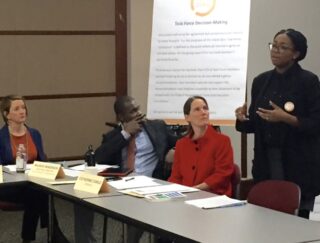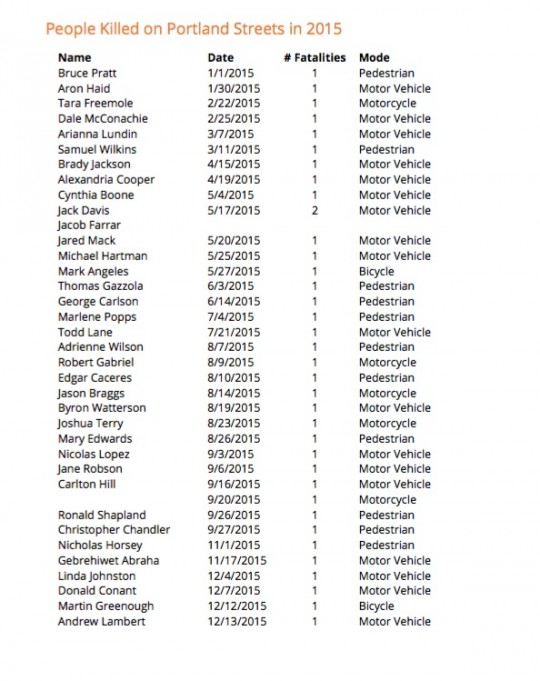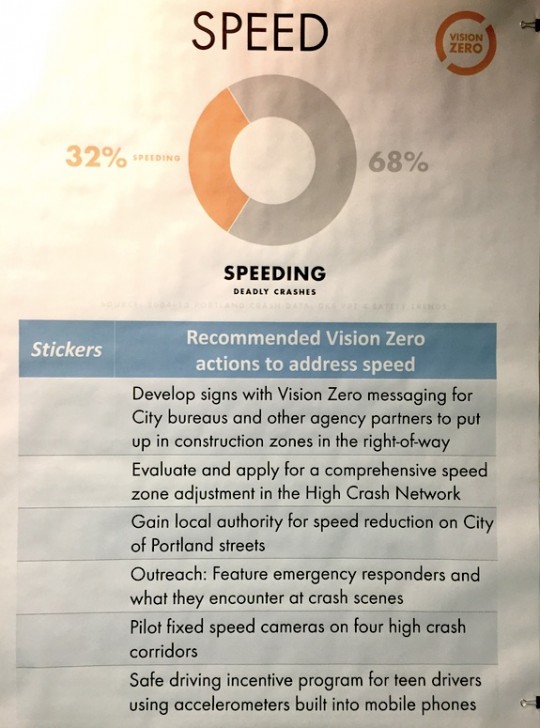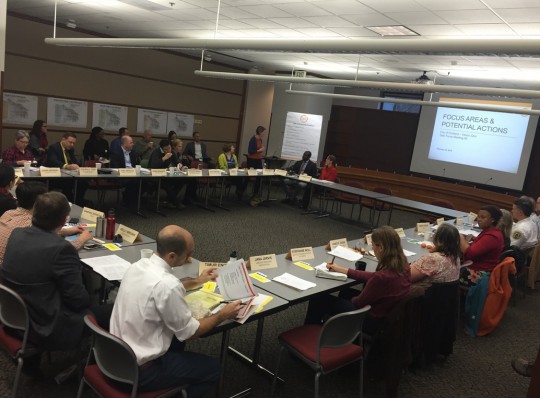
and project consultants Catherine Ciarlo and Joy Davis
with CH2MHill at the Vision Zero Task Force
meeting on February 25th.
(Photos: J. Maus/BikePortland)
Right now in New York City the Director of the Portland Bureau of Transportation Leah Treat, three of her staff (including head Traffic Engineer Steve Townsen), and a Portland Police Bureau sergeant are at the Vision Zero Cities Conference.
The summit features the major leaders in the growing traffic reform movement that is changing how America approaches street culture.
Portland officially adopted Vision Zero as a policy goal last summer; but for Treat it’s more than just another policy. It’s the one issue she’s put more personal and professional capital into than any other since taking over at PBOT nearly three years ago.
“It’s going to take a lot of aggressive measures to achieve Vision Zero. And some courageous conversations.”
— Leah Treat
To make that bold vision a reality, PBOT and Treat are spearheading a multi-agency and interdisciplinary effort that aims to do something many simply believe will never happen: the complete elimination of injuries and deaths on Portland roads by 2025.
“It’s going to take a lot of aggressive measures to achieve Vision Zero,” Treat shared at a meeting of the Vision Zero Task Force late last month. “And some courageous conversations.” It will also take money and Treat has backed up her words with a $500,000 budget request to support Vision Zero. The money will be used for an educational and outreach campaign, a new small grants program for community organizations, and some small-scale infrastructure projects.
One reason courage will be needed to eliminate road deaths is because to do so will require a lot less driving. Portland has had some success in encouraging people to walk, bike and take transit; but the vast majority of Portlanders still get in a car everyday. One reason for that is because our local politicians are much better at promoting cycling and walking than they are at actively discouraging driving.
Why is less driving such an key part of this equation? “More driving equals more dying,” Treat said twice at the recent Task Force meeting, citing a recent report from the National Highway Transportation Safety Administration.
Advertisement
PBOT has assembled a very impressive group of people around this effort. The Task Force includes top brass from the usual transportation advocacy groups; but more importantly from a lot of people and groups you don’t typically see in these discussions: Disability Rights Oregon, AAA, Elders in Action, the Asian Pacific American Network of Oregon, the Portland Fire Bureau, a traffic court judge, a transportation researcher from Portland State University, and so on. (There’s also a Technical Advisory Committee and an Executive Committee.)
And the members of the Task Force are not sitting on their hands. While I was at the meeting they were quick with questions and fully engaged in the discussion. At one point the commander of the police bureau’s traffic division and a fire bureau lieutenant disagreed openly about the impacts of marijuana use on traffic crashes.

So far PBOT’s Vision Zero effort has focused on the “who” and the “where” of traffic crashes in Portland. They’ve poured over data and maps in order to start their attack with a foundation of clear knowledge about the scope of the problem. When it comes to understanding the danger risks in our current system, they looked beyond standard DMV crash data which vastly underreports biking and walking incidents. To do this they added a dataset into their analysis that takes into account road width, vehicle speeds, and so on to find out where vulnerable users are most at risk.

Now the work is moving toward the “what” — which policies and programs will Portland implement to make real progress toward their ambitious goal?
PBOT safety programs manager Gabriel Graff said in a presentation at the meeting that they’ll focus on four priority areas: speeding, impairment, disobeying traffic laws, and road design. Keeping with their commitment to data, PBOT backed up those focus areas with numbers: 32 percent of Portland’s fatal crashes involve speeding, 62 percent are drug and/or alcohol-related, 34 percent are from someone running a red light, and 47 percent of fatalities happened on one of Portland’s 25 most dangerous roads (a.k.a. “high crash corridors”).
PBOT had a poster board up at the meeting for each of the four focus areas. There was a list of about a dozen recommended actions and task force members were asked to place dots on the ones they supported the most.
We’ll keep you posted on Portland’s progress on this important initiative. Later this summer you’ll have a chance to get more involved with the process when PBOT hosts a series of open houses which are slated to start in June. Learn more at VisionZeroPortland.com.
— Jonathan Maus, (503) 706-8804 – jonathan@bikeportland.org
BikePortland can’t survive without subscribers. It’s just $10 per month and you can sign up in a few minutes.


